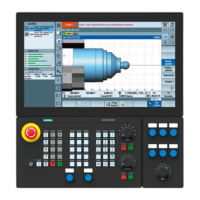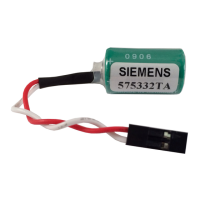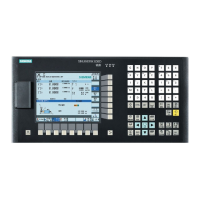© Siemens AG All rights reserved. SINUMERIK, Manual, 5-axis machining
Key functions for 5-axis machining
3.5
59
Spline interpolation
Spline interpolation,
curve interpolation
(ORICURVE)
With spline interpolation, the motion of the ori-
entation vector is defined by the tool tip's
path and the path of a second point on the
tool .
If, for example, you wanted to use circumfer-
ential milling to create an inclined surface, you
would define the surface on which the milling
cutter was to move by means of the two spline
curves at the top and bottom ends of the tool
(1, 2).
The advantage of this is that it enables you to
define a wide variety of surfaces for machining
with a high degree of precision.
Spline interpolation is the best type of interpo-
lation available, but it is also the most involved
and calls for special syntax in the NC program
that must be supported by the CAM system.
Spline/double spline interpolation
ORICURVE Orientation interpolation with specification of the tool tip motion
and that of a second point on the tool. The path of the second
point is defined via XH=… YH=… ZH=…, in conjunction with
BSPLINE as a control polygon with POLY as polynomial:
PO[XH] = (xe, x2, x3, x4, x5) PO[YH] = (ye, y2, y3, y4, y5)
PO[ZH] = (ze, z2, z3, z4, z5)
If the BSPLINE or POLY additional information is omitted,
straightforward linear interpolation will be performed accordingly
between the start and the end orientation.
1
2
1
2

